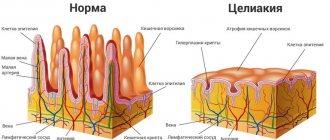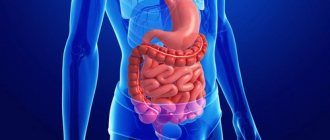What is glucose-galactose malabsorption?
Here are the main points you need to know:
- Glucose-galactose malabsorption (GGM) is a rare metabolic disorder in which the cells lining the intestines are unable to metabolize two specific sugars, glucose and galactose. This disease appears after the birth of the child.
- Sahara . A person with HGM who consumes these sugars has trouble digesting them because they cannot be absorbed by the body. This causes water to remain outside the body's cells, causing diarrhea and dehydration.
- Risk factors for the development of glucose-galactose malabsorption have not been found, since this disease is hereditary, i.e. it is passed down from generation to generation from parents to children. HGM is caused by the inheritance of two copies of a specific gene that are essentially defective.
- Heredity . If it is known that the child's parents or grandparents suffered from glucose-galactose malabsorption, then most likely this child will have this disease. If there is constant, watery diarrhea in the first few days of his life, then the child has HGM. However, the severity of symptoms may vary from one child to another.
- The diagnosis of glucose-galactose malabsorption is usually made early in a child's life. There are also special diagnostic procedures that can be performed with the help of medical personnel to make a physical diagnosis of this metabolic disorder.
- Complications . Complications of glucose-galactose malabsorption include: dehydration during the first few days of an infant's life. Severe diarrhea and loss of large amounts of water from the body. Adults with HGM often experience abdominal discomfort (bloating, diarrhea, nausea, and cramps) after eating foods that contain certain sugars (milk sugar and table sugar).
- Treatment . To treat glucose-galactose malabsorption, it is necessary to avoid consuming sugars found in certain foods. These sugars are replaced with fructose (fruit sugar).
- The prognosis for HGM is positive. As long as you avoid these sugars and foods containing them, symptoms will not be felt. However, the disease is incurable and is present throughout a person's life.
Prevention
Preventive measures for glucose-galactose malabsorption syndrome involve preventing illnesses that can cause its occurrence. These include:
- pathological changes in the pancreas, liver;
- inflammatory bowel diseases;
- endocrine system disorders;
- diseases of the gastrointestinal tract.
In case of existing congenital diseases of the enzymatic system, the best preventive action for malabsorption syndrome is considered to be timely detection of a deficiency of a specific enzyme, as well as correct drug correction.
To prevent hypovitaminosis, you need to take vitamin-mineral complexes seasonally. Equally important is a suitable, healthy diet, which requires:
- inadmissibility of overeating;
- exclusions from the menu of fatty, fried, spicy, salty foods;
- eating small portions.
An active lifestyle, sports, and moderate physical activity will help to significantly reduce the likelihood of developing malabsorption syndrome.
With timely treatment of glucose-galactose malabsorption, the prognosis will be positive. In case of a complicated form of impaired absorption of monosaccharides, following a diet helps to significantly improve the patient’s quality of life. However, late detection of malabsorption syndrome leads to the baby’s vision deteriorating and developing dementia.
The information on our website is provided by qualified doctors and is for informational purposes only. Don't self-medicate! Be sure to consult a specialist!
Author: Rumyantsev V. G. Experience 34 years.
Gastroenterologist, professor, doctor of medical sciences. Prescribes diagnostics and carries out treatment. Expert of the group for the study of inflammatory diseases. Author of more than 300 scientific papers.
Risk factors (predisposing factors)
Glucose-galactose malabsorption is a hereditary disease passed from generation to generation. Heredity is the main risk factor. There are no other known risk factors that predispose to the development of this disease.
It is important to note that the presence of a risk factor does not mean that a person will necessarily suffer from HGM. A risk factor increases the likelihood of developing this disease compared to a person without risk factors. Additionally, the absence of risk factors does not mean that a person cannot be born with the disease.
The only risk factor for the development of glucose-galactose malabsorption is the genetic factor (heredity)
Causes of occurrence (etiology)
HGM occurs due to a genetic abnormality:
- Glucose-galactose malabsorption is a disease that is caused by the inheritance of a certain gene that is responsible for the production of a protein involved in the transport of sodium and glucose. This protein is found primarily in the gastrointestinal tract.
- A mutation that occurs in this gene changes its sequence, resulting in the inability of cells in the intestines to absorb glucose and galactose.
- This gene (known as the SLC5A1 gene) depends on sodium to transport glucose and galactose. HGM occurs when two mutant copies of this gene are inherited. This is called an autosomal recessive mechanism of inheritance of the disease.
Autosomal recessive diseases occur when two copies of an abnormal gene have been inherited on a non-sex chromosome. If both parents have an autosomal recessive disorder, the chance of passing on the mutated genes to their child is 100%. If only one mutant copy of the gene is inherited, the individual will be a carrier of the disease but will not experience any of its symptoms. Children born to two carriers have a 25% chance of being homozygous dominant (without symptoms of the disease), a 50% chance of being heterozygous (carrier), and a 25% chance of being homozygous recessive (with symptoms of the disease).
Signs and symptoms of glucose-galactose malabsorption
Signs and symptoms of glucose-galactose malabsorption include:
- A severe form of diarrhea and dehydration that occurs during the first few days (or even on the very first day) of the baby's life.
- Adults with HGM often experience bloating and discomfort, nausea, diarrhea, and abdominal pain.
Malabsorption syndrome in children may vary in severity of signs and symptoms. Some may experience mild signs and symptoms, while others may have severe symptoms.
Diagnostics
Diagnostics involves laboratory and hardware testing. Signs of malabsorption syndrome are detected by examining samples of blood, urine, and feces. A clinical blood test shows the presence of iron deficiency anemia and B12 deficiency, prolongation of prothrombin time indicates a lack of vitamin K. Biochemical analysis shows the amount of albumin, calcium and alkaline phosphatase.
The coprogram demonstrates whether muscle fibers or starch are present in the stool. Due to the lack of certain enzymes, the pH of the stool may change. To clarify the diagnosis, a stool test for occult blood and pathogenic protozoa may be required. Bacteriological examination of feces should reveal the amount of pathogenic flora in one gram of feces and determine whether an intestinal infection is present and whether the patient is a carrier of the bacteria.
Fat absorption is determined using the steatorrhea test. Before the patient takes a stool test, he must consume 100 grams of fat for several days. Then the daily stool is examined and the amount of fat in it is determined (the norm is less than 7 grams). If the fat value is exceeded, then malabsorption is suspected.
If more than 14 grams of fat is secreted, pancreatic dysfunction is indicated. With grade 3 malabsorption and gluten intolerance, half of the fat consumed is excreted in the feces. Functional tests (D-xylose and Schilling's tests) are performed to detect malabsorption in the small intestine.
The patient is given a portion (5 g) of D-xylose, and after 2 and 5 hours the urine is collected and the level of the substance is determined. With normal absorption, up to 0.7 g of xylose will be released in 2 hours and 1.2 g in 5 hours. The Schilling test shows whether vitamin B12 is completely absorbed. The patient is given a labeled vitamin to drink, and then it is determined how much of it is released per day (the norm is 10%, less than 5% indicates a violation).
To determine the causes of malabsorption syndrome, a hardware examination is performed. X-ray irradiation can detect signs of pathologies of the small intestine, for example, interintestinal anastomoses, strictures, diverticula, ulcerations, blind loops, horizontal accumulations of liquid or gas.
Ultrasound, MRI and MSCT of the abdominal cavity make it possible to visualize organs and identify pathologies that are the root cause of the development of malabsorption syndrome. Endoscopic examination of the small intestine confirms Whipple's disease, intestinal lymphangiectasia, celiac disease, and amyloidosis.
During the study, a tissue sample is taken for histology and liquid for a bacteriological test. The hydrogen breath test with lactase confirms lactase deficiency, and the test with lactulose shows whether there is bacterial overgrowth syndrome.
A pathology such as glucose-galactose malabsorption is a hereditarily determined syndrome caused by inadequate absorption of monosaccharides in the gastrointestinal tract. Often, together with a digestion disorder, the process of reabsorption of simple carbohydrates in the kidneys occurs.
Diagnosis of glucose-galactose malabsorption
Hydrogen breath test
To diagnose glucose-galactose malabsorption, the following tests and analyzes are used:
- A thorough assessment of family medical history and a complete physical examination.
- The presence of persistent, watery diarrhea during the first few days of an infant's life causes the attending physician to suspect HGM.
If the doctor suspects the presence of glucose-galactose malabsorption syndrome, he may refer for the following diagnostic procedures:
- Hydrogen breath test. This test is used to detect lactose (milk sugar) intolerance. To do this, you need to exhale into a special bag that looks like a balloon. The purpose of this test is to detect hydrogen in the exhaled air, the presence of which indicates malabsorption (malabsorption syndrome).
- As a rule, the level of hydrogen in the air exhaled by a person is very low. Elevated hydrogen levels indicate lactose intolerance, which is a sugar containing glucose and galactose.
Many clinical conditions may have similar signs and symptoms. Your doctor may perform additional tests to rule out other conditions to help make a definitive diagnosis.
Classification of malabsorption syndrome
Depending on the severity, malabsorption can be mild, moderately severe or severe:
- I degree of severity is considered the mildest and is characterized by a decrease in body weight (no more than 5-10 kilograms), decreased performance, increased weakness and the appearance of signs of general multivitamin deficiency;
- II degree of severity is characterized by severe body weight deficiency (in about half of the cases, weight decreases by more than 10 kilograms), pronounced symptoms of multivitamin deficiency, deficiency of electrolytes (calcium and potassium), symptoms of anemia, reduced function of the gonads;
- III degree of severity is characterized by a decrease in body weight by more than 10 kilograms in the vast majority of patients, severe symptoms of multivitamin deficiency (which are observed in all people in this group without exception), electrolyte deficiency, frequent seizures, manifestations of osteoporosis, the development of anemia, and the appearance of edema , dysfunction of the endocrine system.
Depending on the nature of the origin, malabsorption can be:
- Congenital;
- Acquired.
The congenital form occurs in only a tenth of all patients with malabsorption syndrome. As a rule, these are people who have been diagnosed with:
- Gluten enteropathy;
- Cystic fibrosis;
- Lactase deficiency;
- Sucrase deficiency;
- Cystinuria;
- Hartnup disease;
- Shwachman-Diamond syndrome, etc.
The acquired form of malabsorption is a consequence of:
- Transferred enteritis;
- Tropical sprue (a chronic, severe disease of the gastrointestinal tract of unknown etiology, which is characterized by pathological changes in the mucous membrane of the small intestine);
- Idiopathic hypoproteinemia;
- Chronic pancreatitis;
- Malignant neoplasms in the small intestine;
- Liver cirrhosis, etc.
Approximately three out of a hundred patients with acquired malabsorption syndrome have an intolerance to the protein contained in cow's milk.
Complications of glucose-galactose malabsorption
Glucose-galactose malabsorption can cause the following complications:
- Severe dehydration as a result of severe diarrhea early in the infant's life.
- Nutrient deficiencies can occur due to severe diarrhea and dehydration.
- In adults with glucose-galactose malabsorption, abdominal complications may occur when consuming certain sugars.
- Osteopenia is a decrease in bone mineral density.
- Osteoporosis is thinning of bone tissue, weakening of bones and increasing the risk of fractures.
Symptoms
Malabsorption syndrome has both general and specific symptoms. They usually appear gradually in children and adults.
General symptoms of impaired absorption processes in the intestines:
- weight loss. Since a sufficient amount of nutrients is not absorbed in the intestines, the body does not receive adequate nutrition;
- pain syndrome in the upper abdomen. May radiate to the lumbar region;
- bloating;
- flatulence;
- asthenovegetative syndrome. As malabsorption progresses, a person experiences increased fatigue, weakness, and apathy. All this happens due to a lack of nutrients that are so necessary for the central nervous system;
- After eating, the patient immediately passes gas. This symptom is due to the fact that too much undigested food has accumulated in the small and large intestines;
- diarrhea. This is a characteristic symptom of malabsorption in children and adults. The volume of excrement increases significantly. They become foul-smelling and watery. If the cause of malabsorption is cholestasis, then the stool will have an oily sheen (undigested fats);
- skin damage. The patient experiences brittle nails, dry skin, glossitis, seborrhea, and dermatitis. It is also possible that minor hemorrhages in the skin and mucous membranes may occur.
Specific symptoms of malabsorption:
- formation of peripheral edema. Since protein absorption is impaired in the intestines, swelling of the legs and feet appears. In severe cases, there is an accumulation of exudate in the abdominal cavity;
- hypovitaminosis. Since the body does not receive enough of the vitamins it needs, a person may begin to experience the following conditions: night blindness, neuropathy, pain in joints and bones, hemorrhages under the skin, bleeding gums, etc.;
- dysfunction of the glands of the endocrine system. Amenorrhea and sexual dysfunction develop (in the stronger sex);
- disturbance of mineral metabolism. If there is a calcium deficiency, the patient experiences bone pain and cramps. With potassium deficiency, weakness of muscle structures is noted. With a deficiency of zinc and iron, anemia progresses and various rashes appear on the skin.
Treatment of glucose-galactose malabsorption
Glucose-galactose malabsorption syndrome is considered an incurable disease. However, it can be controlled as follows:
- Removing glucose and galactose from the diet. In order to avoid consuming glucose and galactose, it is necessary to completely eliminate milk and dairy products from the diet.
- It is most often recommended to avoid sucrose (table sugar), lactose (the sugar found in milk and dairy products), and glucose from the diet. Fructose (fruit sugar) is used to replace these sugars.
Treatment of malabsorption
Treatment of malabsorption involves prescribing to the patient:
- Special diet;
- Drug therapy, which involves the use of drugs whose action is aimed at correcting the deficiency of vitamins and minerals resulting from malabsorption; hormonal, antisecretory, choleretic, antidiarrheal and antibacterial medications. Patients are also shown antacids and pancreatic enzymes.
In some cases, surgical treatment of malabsorption may be necessary. The operation is carried out taking into account the disease that led to the development of such pathology. This could be resection of lymphatic vessels, liver transplantation, sclerosis of the esophageal veins, total colectomy, etc.
The only method of treating glucose and galactose malabsorption in children today is to prescribe them a strict diet that excludes from the diet all foods that may contain monosaccharides.
How to prevent glucose-galactose malabsorption
Currently, there are no specific methods or guidelines to prevent glucose-galactose malabsorption, as the disease is genetic. To understand the risk of a baby's HGM, parents (and related family members) are advised to undergo genetic testing and prenatal diagnosis (non-invasive prenatal testing during pregnancy).
If your family has relatives suffering from HGM, then before planning a child you are recommended to undergo genetic counseling - this will help assess the risks of developing this disease in the child. Active research is currently underway to explore the treatment and prevention of inherited and acquired genetic diseases such as glucose-galactose malabsorption.
Forecast
The medical prognosis for glucose-galactose malabsorption is good if certain dietary restrictions are strictly followed. However, this disease must be monitored throughout life. The diet for malabsorption completely excludes some sugars (lactose, sucrose, glucose and galactose). A person with HGM must completely eliminate milk and dairy products from their diet. Infants with glucose-galactose malabsorption are fed a special formula that does not contain glucose, galactose and lactose. Feeding with breast milk or regular infant formula should be avoided.











